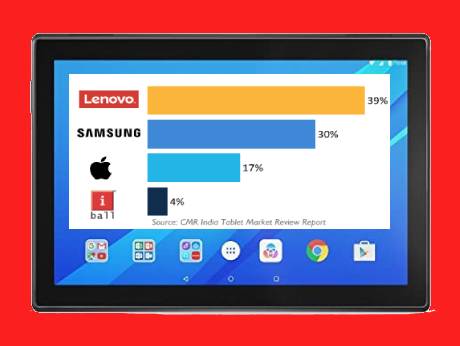
New Delhi, March 19, 2021: Lenovo leads India’s Tablet PC Market -- according to CMR’s Tablet PC Market Report Review for CY2020.
While the Tablet market grew 6% year-on-year (YoY), 4G Tablets grew sequentially by 7% YoY. Interestingly, during the course of the year, a premium brand such as Apple replaced a strong value-for-money brand such as iBall in the top three brands.
Lenovo led the market with a 39% market share. Lenovo’s commercial business saw good growth, driven by government and education sectors. Lenovo maintained good score on tablet market demand in the last 14 consecutive quarters. Lenovo Tab M10 (HD) series garnered 10% market share.
Samsung was placed second with 30% market share. Samsung launched several Tablets in 2020, including the Tab A7 LTE & WiFi version, Tab S7, S7 Plus & S6 lite. Across all the tablet launches from Samsung, the Tab A7 LTE & WiFi was the most successful, accounting for a massive 13% share across the Samsung tablet portfolio.
Apple replaced iBall at the third position for CY2020 with 17% market share. As uncertainties owing to COVID-19 pandemic continue to persist, Apple has a good opportunity to increase its market share in the overall tablet market. With launch of Apple iPad 8, iPad Air and iPad Pro contributed to this market growth with 44% of the overall iPad shipments during this year. Apple registered strong growth in CY2020. It also had the largest share in the premium segment (> INR 30,000). Apple iPad demand spiked through CY2020.
Says Menka Kumari, Analyst-Industry Intelligence Group (IIG), CMR, “Amidst the pandemic, opportunities and demand created by work-from-home (WFH) and learning-from-home (LFH) created a strong uptick the Indian tablet industry in Year 2020. Exciting deals during festive season further boosted Indian tablet market in the year. A new shift in dependency over tablets in Healthcare sector, enterprises and home usage backed the tablet market growth furthermore.”
Future Outlook
CMR anticipates an overall growth of shipments around 5-10% in CY2021, with a slower than expected Q1 2021 due to muted consumer demand. “In CY2021, we anticipate the Tablet market to start on a slower note. This is primarily because much of the consumer demand was fulfilled in the festive season. However, we anticipate the tablet demand to pick-up in Q2 2021 driven by the education sector, and digital transformation in the post-vaccine world,” adds Menka.
Lenovo led the market with a 39% market share. Lenovo’s commercial business saw good growth, driven by government and education sectors. Lenovo maintained good score on tablet market demand in the last 14 consecutive quarters. Lenovo Tab M10 (HD) series garnered 10% market share.
Samsung was placed second with 30% market share. Samsung launched several Tablets in 2020, including the Tab A7 LTE & WiFi version, Tab S7, S7 Plus & S6 lite. Across all the tablet launches from Samsung, the Tab A7 LTE & WiFi was the most successful, accounting for a massive 13% share across the Samsung tablet portfolio.
Apple replaced iBall at the third position for CY2020 with 17% market share. As uncertainties owing to COVID-19 pandemic continue to persist, Apple has a good opportunity to increase its market share in the overall tablet market. With launch of Apple iPad 8, iPad Air and iPad Pro contributed to this market growth with 44% of the overall iPad shipments during this year. Apple registered strong growth in CY2020. It also had the largest share in the premium segment (> INR 30,000). Apple iPad demand spiked through CY2020.
Future Outlook
CMR anticipates an overall growth of shipments around 5-10% in CY2021, with a slower than expected Q1 2021 due to muted consumer demand. “In CY2021, we anticipate the Tablet market to start on a slower note. This is primarily because much of the consumer demand was fulfilled in the festive season. However, we anticipate the tablet demand to pick-up in Q2 2021 driven by the education sector, and digital transformation in the post-vaccine world,” adds Menka.